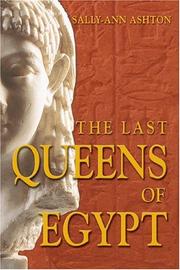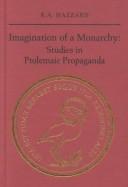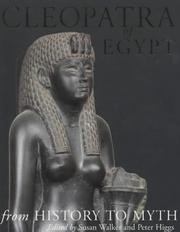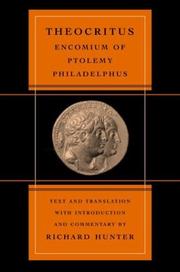| Listing 1 - 10 of 17 | << page >> |
Sort by
|

ISBN: 1317868722 131583572X 1317868730 9781317868736 9781317868729 0582772109 9780582772106 Year: 2014 Publisher: Oxon [England] : Routledge,
Abstract | Keywords | Export | Availability | Bookmark
 Loading...
Loading...Choose an application
- Reference Manager
- EndNote
- RefWorks (Direct export to RefWorks)
The last of the Ptolemaic monarchs who ruled Egypt for 300 years, Cleopatra is the most famous of the Ptolemaic queens. But what of her predecessors? The Last Queens of Egypt examines the roles played by the Ptolemaic royal women and explores their part in religion, politics and court intrigue. Explaining their propensity for incest, murder and power, Sally Ann Ashton shows the extent of the power they enjoyed, the price they paid, and how they shaped Cleopatra's reign.
Queens --- History. --- Ptolemaic dynasty, --- Egypt --- History
Book
ISBN: 9783406569333 3406569331 2821846495 Year: 2008 Volume: 98 Publisher: C.H.Beck
Abstract | Keywords | Export | Availability | Bookmark
 Loading...
Loading...Choose an application
- Reference Manager
- EndNote
- RefWorks (Direct export to RefWorks)
Unter der Herrschaft der makedonisch-griechischen Dynastie der Ptolemäer (323–30 v. Chr.) entstand in Ägypten eine multikulturelle Gesellschaft. Die fremden Könige ließen ihre Untertanen nach der je eigenen Fasson leben: Die zahlreichen, meist griechischen Zuwanderer stellten zwar die deutlich privilegierte Schicht, doch sorgten die Könige auch für die einheimischen Kulte und förderten die ägyptische Priesterschaft. Um aber in dieser Pluralität der Lebensformen und Religionen eine sinnstiftende Klammer zu schaffen, richtete man den Personenkult für den lebenden König ein. Ziel des Autors ist es, die verschiedenen Formen des Kultes für den König und seine Gemahlin zu beschreiben. Erstmals legt er mit dem vorliegenden Buch eine Zusammenschau der Ergebnisse der klassischen Altertumswissenschaften und der Ägyptologie vor. Hieraus ergibt sich folgende These, die gleichzeitig den Aufbau des Buches bestimmt: Es gab nicht den einen Herrscherkult, sondern verschiedene Formen des Kultes, und jeder Untertan konnte die ihm zusagende Form wählen. Einerseits bestand die Möglichkeit, den König und seine Gemahlin mit griechischen Bräuchen zu verehren. In diesem Fall ist von griechischem Herrscherkult zu sprechen. Vielfach stellte man die Verehrung des lebenden Herrscherpaares auch in den Kontext der Ahnen – es handelte sich dann um einen griechischen Dynastiekult. Die ägyptischen Priester entwickelten aus den beiden griechischen Kultmöglichkeiten spezifisch ägyptische Formen. Sie integrierten die lebenden Pharaonen als Götter in die ägyptischen Tempel; so etwas hatte es in Ägypten bis dahin noch nicht gegeben. Mittels großer Prozessionen wurde an den Herrscherfesttagen der Bevölkerung die Möglichkeit gegeben, den Kult für die Könige ebenfalls zu zelebrieren. Der von den einheimischen Priestern betriebene Herrscherkult trug also wesentlich zur Legitimation der Fremdherrschaft in Ägypten bei. Im Fließtext der Monographie wurde auf fremdsprachige ägyptische oder griechische Zitate…
Ptolemaic dynasty, --- Egypt --- Egypte --- Civilization --- Kings and rulers. --- Civilisation --- Rois et souverains --- Kings and rulers --- History & Archaeology --- Regions & Countries - Africa --- Herrscherkult. --- Ptolemäer. --- Ptolemäer. --- Ptolemaic dynasty, - 305-30 BC --- Egypt - Civilization - 332 BC-638 AD --- Egypt - Kings and rulers --- Herrscherkult --- Multikulturalismus --- Ptolemäer --- Lagides (dynastie) --- Égypte --- Aspect religieux --- 332 av. J.-C.-640
Book
ISBN: 9783406736612 3406736610 9791036555848 Year: 2020 Volume: 117 Publisher: München C.H.Beck
Abstract | Keywords | Export | Availability | Bookmark
 Loading...
Loading...Choose an application
- Reference Manager
- EndNote
- RefWorks (Direct export to RefWorks)
In der vorliegenden Arbeit stellt der Autor in knappen, sich auf das Wesentliche beschränkenden Ausführungen einen der wichtigsten Aspekte der Wirtschaft Ägyptens in hellenistischer Zeit dar: das Phänomen Geld. Er gliedert die Arbeit in folgende Kapitel: Die Metalle, die Organisation, die Fabrikation, die Nominale, die Bilder, Beizeichen und Legenden, die Monogramme und Abbreviaturen, die Überprägungen und Gegenstempelungen, die „Ära“-Prägungen, kalendarische Fragen, die Werterelationen, die Gewichtsreduktionen, die Metallverschlechterungen, die Aufhebung der Silber-Bronze-Relation, die Kaufkraft, die Binnenwährung, der Außenhandel, die Münzhorte, die Erfolge im Ausland. Ein umfangreiches Literaturverzeichnis beschließt die Arbeit.
Droit --- Geld. --- Monnaies lagides --- Politique monétaire --- Histoire. --- Ptolemäer, --- Lagides --- Numismatique. --- Money --- Monetary policy --- History. --- Ptolemaic dynasty, --- Coins, Egyptian --- Egypt --- Economic conditions --- Economics --- History --- Hellenistische Zeit --- Wirtschaft im Alten Ägypten --- Monogramme --- Abbreviatur --- Gegenstempel --- Münzhorte --- Münzverschlechterung --- Kaufkraft
Book
ISSN: 09363718 ISBN: 3406629156 3406629164 2821846436 9783406629150 Year: 2011 Volume: 104. Heft Publisher: München : Verlag C.H. Beck,
Abstract | Keywords | Export | Availability | Bookmark
 Loading...
Loading...Choose an application
- Reference Manager
- EndNote
- RefWorks (Direct export to RefWorks)
Hauptbeschreibung Die Verwaltung Ägyptens in ptolemaiischer Zeit ist insbesondere aufgrund von zahlreichen Papyrusfunden relativ gut bezeugt. Dennoch bleiben viele Fragen - nicht zuletzt im Hinblick auf die Verwaltung der Provinzen und der Einflussgebiete. Trotz der angedeuteten Schwierigkeiten wird hier zum ersten Mal der Versuch unternommen, ein Gesamtbild der Verwaltung des ptolemaiischen Reichs zu erstellen. Die Arbeit gliedert sich in zwei große Teile: Im ersten Teil werden die Verwaltungskompetenzen der Funktionäre untersucht, im zweiten Teil werden die Verwaltungsmaßnahme
Egypt -- History -- 332-30 B.C. -- Chronology. --- Ptolemaic dynasty, 305-30 B.C. --- Chronology, Greek. --- History & Archaeology --- Regions & Countries - Africa --- Egypt --- History --- Administrative agencies --- History. --- Ptolemaic dynasty, --- Politics and government --- Officials and employees. --- Egypt - History - 332-30 B.C. --- Ägypten --- Ptolemäer --- Funktionäre --- Verwaltung --- Administration locale --- Égypte --- Antiquité --- Politique et gouvernement --- 332-30 av. J.-C. Égypte --- Administration --- Égypte --- 332-30 av. J.-C. Égypte
Multi
ISBN: 9781107007758 1107007755 9781139035231 1108707807 1316010163 1139989545 1316005666 131600340X 1139035231 1316012409 1316001164 9781316003404 9781316010167 Year: 2014 Volume: *1 Publisher: Cambridge, England
Abstract | Keywords | Export | Availability | Bookmark
 Loading...
Loading...Choose an application
- Reference Manager
- EndNote
- RefWorks (Direct export to RefWorks)
This is the only substantial and up-to-date reference work on the Ptolemaic army. Employing Greek and Egyptian papyri and inscriptions, and building on approaches developed in state-formation theory, it offers a coherent account of how the changing structures of the army in Egypt after Alexander's conquest led to the development of an ethnically more integrated society. A new tripartite division of Ptolemaic history challenges the idea of gradual decline, and emphasizes the reshaping of military structures that took place between c.220 and c.160 BC in response to changes in the nature of warfare, mobilization and demobilization, and financial constraints. An investigation of the socio-economic role played by soldiers permits a reassessment of the cleruchic system and shows how soldiers' associations generated interethnic group solidarity. By integrating Egyptian evidence, Christelle Fischer-Bovet also demonstrates that the connection between the army and local temples offered new ways for Greeks and Egyptians to interact.
Ancient history --- Antiquity --- Egypt --- Forces armées --- Armies --- Ptolemaic dynasty, 305-30 B.C. --- Aspect social --- History. --- History --- Sociology, Military --- Armies. --- Sociology, Military. --- Gesellschaft. --- Militär. --- Ptolemaic dynasty, --- Egypt. --- To 1500. --- Ägypten. --- History, Military --- Military sociology --- Armed Forces --- Peace --- War --- War and society --- Army --- Military power --- مصر. --- Ptolemaic dynasty, 305 B.C.-30 B.C. --- Égypte --- Ägypten --- Egitto --- Egipet --- Egiptos --- Miṣr --- Southern Region (United Arab Republic) --- Egyptian Region (United Arab Republic) --- Iqlīm al-Janūbī (United Arab Republic) --- Egyptian Territory (United Arab Republic) --- Egipat --- Arab Republic of Egypt --- A.R.E. --- ARE (Arab Republic of Egypt) --- Jumhūrīyat Miṣr al-ʻArabīyah --- Mitsrayim --- Egipt --- Ijiptʻŭ --- Misri --- Ancient Egypt --- Gouvernement royal égyptien --- جمهورية مصر العربية --- مِصر --- مَصر --- Maṣr --- Khēmi --- エジプト --- Ejiputo --- Egypti --- Egypten --- מצרים --- United Arab Republic --- Egyptian Army --- Egyptian Ground Forces --- Jaysh al-Miṣrī --- Qūwwāt al-Baḥrīyah al-Miṣrīyah --- جيش المصري --- قوات البرية المصرية --- Forces armées

ISBN: 0802043135 9786612028427 1282028421 1442676000 9781442676008 9780802043139 Year: 2000 Volume: 37 37 Publisher: Toronto
Abstract | Keywords | Export | Availability | Bookmark
 Loading...
Loading...Choose an application
- Reference Manager
- EndNote
- RefWorks (Direct export to RefWorks)
"Scholars have long known that the Ptolemaic monarchy of Egypt underwent a transformation between 323 and 30 B.C. The queens of that dynasty started as subordinates of the kings but ended as their superiors. Exactly when and how this change occurred has proven problematic for modern scholars. R.A. Hazzard argues that this change was put in motion by Ptolemy II, who glorified his sister Arsinoe and made acceptable a civilian style of kingship based on piety towards his real and mythical ancestors. Ptolemy's support and elevation of his sister inspired the queens of the line to assert themselves at the expense of their male associates. The process culminated in the absolute rule of Kleopatra VII after 47 B.C." "Hazzard presents a clear argument based on the numismatic, epigraphical, papyrological, literary, and historical sources."--Jacket.
Monarchy --- -Propaganda, Egyptian --- Queens --- -Egyptian propaganda --- Royalty --- Rulers --- Sovereigns --- Women --- Courts and courtiers --- Empresses --- Kings and rulers --- Kingdom (Monarchy) --- Executive power --- Political science --- Royalists --- History --- Biography --- Ptolemaic dynasty --- Egypt --- -Monarchy --- Egypte --- Ägypten --- Egitto --- Egipet --- Egiptos --- Miṣr --- Southern Region (United Arab Republic) --- Egyptian Region (United Arab Republic) --- Iqlīm al-Janūbī (United Arab Republic) --- Egyptian Territory (United Arab Republic) --- Egipat --- Arab Republic of Egypt --- A.R.E. --- ARE (Arab Republic of Egypt) --- Jumhūrīyat Miṣr al-ʻArabīyah --- Mitsrayim --- Egipt --- Ijiptʻŭ --- Misri --- Ancient Egypt --- Gouvernement royal égyptien --- -Propaganda, Egyptian. --- Propaganda, Egyptian. --- Egyptian propaganda --- Ptolemaic dynasty, --- History. --- Propaganda, Egyptian --- Biography. --- 332-30 B.C. --- Ptolemaic dynasty, - 305-30 B.C. --- Monarchy - Egypt - History. --- Queens - Egypt - History. --- Queens - Egypt - Biography.

ISBN: 2271052777 9782271052773 2271078415 Year: 1995 Volume: *1 Publisher: Paris : C.N.R.S.-Editions (Centre National de la Recherche Scientifique),
Abstract | Keywords | Export | Availability | Bookmark
 Loading...
Loading...Choose an application
- Reference Manager
- EndNote
- RefWorks (Direct export to RefWorks)
Pourquoi, contrairement aux habitudes des cités grecques et malgré les avertissements de Platon qui avait dénoncé les dangers d’établir une ville au bord de la mer, Alexandrie a-t-elle choisi le plus mauvais mouillage de la Méditerranée, bordé de marécages et de déserts ? Pourquoi un général de vingt-quatre ans, avant tout soucieux de « casser du Perse », a-t-il tout à coup décidé, en janvier 331 av. J. - C , de fonder une ville qui deviendrait la capitale de l’Égypte ? Pourquoi un prince macédonien a-t-il élu la terre africaine pour y faire naître une nouvelle Athènes ? Comment, en quelques jours et en pleine campagne contre le roi de Perse, a-t-on dessiné les contours et établi le plan de ce qui deviendra « l’entrepôt de la terre habitée »? Comment des rois grecs se sont-ils succédé durant trois siècles sur le trône des Pharaons ? Comment s’est résolue l’opposition du Grec et du Barbare, et comment est apparue une civilisation qui s’appellera « alexandrine » et qui sera fondée sur le métissage ? Pourquoi les initiateurs de cette culture nouvelle n’ont-ils pu régner que par l’inceste et l’assassinat ? Pourquoi l’équilibre politique et culturel ainsi réalisé s’est-il soudain effondré quand les navires d’Octavien se sont présentés devant le port d’Alexandrie, entraînant le suicide de Marc-Antoine et celui de Cléopâtre VII, la grande Cléopâtre ? À toutes ces questions André Bernand apporte des réponses, en montrant que, sur le destin d’Alexandrie, plane une grande figure de l’Antiquité, qu’il a su identifier... « Patrimoine de la Méditerranée » : une collection qui se propose de retrouver l’esprit des lieux, de les faire revivre à travers leur histoire, de susciter l’imagination du passé. Chaque ouvrage, s’appuyant sur les acquis les plus récents de la recherche, s’organise autour d’un thème privilégié.
Ptolemaic dynasty, --- Alexandria (Egypt) --- Alexandrie (Egypte) --- Civilization --- History --- Civilisation --- Histoire --- Dynastie des Lagides (Égypte, 305-30 av. J.-C.) --- Alexandrie --- Egypte --- Ptolémée, dynastie. --- Alexandrie (Égypte) --- Dynastie des Lagides (Égypte, 305-30 av. J.-C.). --- Egypte. --- Alexandrie (Égypte). --- History. --- Archaeology --- Dynastie ptolémaïque --- Ptolémées --- époque hellénistique

ISBN: 0714119431 0741419385 0714119385 9780714119380 Year: 2001 Publisher: London British Museum Press
Abstract | Keywords | Export | Availability | Bookmark
 Loading...
Loading...Choose an application
- Reference Manager
- EndNote
- RefWorks (Direct export to RefWorks)
Fabled for her sexual allure and cunning intelligence, Cleopatra VI of Egypt has fascinated generations of admirers and detractors since her tumultuous life ended in suicide on Octavian's capture of Egypt in 30 BC. The last of the Ptolemaic monarchs who had ruled Egypt as Hellenistic Greek kings and Egyptian pharaohs for 300 years. Cleopatra created her own mythology, becoming an icon in her own lifetime and even more so after her death. This lavishly illustrated catalogue, published to accompany a major exhibition at the British Museum, explores the ways in which she was depicted in antiquity, within the context of the iconography of contemporary coinage, statues and other images of Egyptian, Greek and Roman rulers. Exciting new research has revealed seven Egyptian-style statues believed to represent Cleopatra, and two portraits probably commissioned in Rome while she lived there as the guest of Julius Caesar. The book also examines the image of Cleopatra from the Renaissance to modern times, as seen in plays, opera, painting, ceramics and even jewellery. Finally, recent archaeological finds from Alexandria - Cleopatra's capital - and from Rome illuminate life in Cleopatra's day and her impact on the capital of the known world.
7.032.2 --- CDL --- Semiotics --- Cleopatra VII --- Queens --- Cleopatra, --- Ptolemaic dynasty, --- Egypt --- Antiquities --- Civilization --- Queens - Egypt - Exhibitions --- Cleopatra, - Queen of Egypt, - -30 B.C. - Exhibitions --- Egypt - Antiquities - Exhibitions --- Egypt - Civilization - 332 B.C.-638 A.D. - Exhibitions --- Cleopatra, - Queen of Egypt, - -30 B.C.
Book
ISBN: 178570138X 1785701363 9781785701368 9781785701382 9781785701375 1785701371 9781785701351 1785701355 Year: 2016 Publisher: Oxford Philadelphia
Abstract | Keywords | Export | Availability | Bookmark
 Loading...
Loading...Choose an application
- Reference Manager
- EndNote
- RefWorks (Direct export to RefWorks)
Excavations (Archaeology) --- Pottery, Egyptian. --- Egyptian pottery --- Archaeological digs --- Archaeological excavations --- Digs (Archaeology) --- Excavation sites (Archaeology) --- Ruins --- Sites, Excavation (Archaeology) --- Archaeology --- Ptolemaic dynasty, --- Dakhla Oasis (Egypt) --- Egypt --- al-Dakhilah (Egypt) --- Dakhilah Oasis (Egypt) --- Dakhleh Oasis (Egypt) --- ed Dakhla (Egypt) --- el Dakhla (Egypt) --- History. --- Antiquities. --- Economic conditions

ISBN: 0520235606 1282356968 0520929373 9786612356964 1597345962 9780520929371 1417525665 9781417525669 9780520235601 Year: 2003 Volume: 39 Publisher: Berkeley University of California Press
Abstract | Keywords | Export | Availability | Bookmark
 Loading...
Loading...Choose an application
- Reference Manager
- EndNote
- RefWorks (Direct export to RefWorks)
Under Ptolemy II Philadelphus, who ruled Egypt in the middle of the third century B.C.E., Alexandria became the brilliant multicultural capital of the Greek world. Theocritus's poem in praise of Philadelphus-at once a Greek king and an Egyptian pharaoh-is the only extended poetic tribute to this extraordinary ruler that survives. Combining the Greek text, an English translation, a full line-by-line commentary, and extensive introductory studies of the poem's historical and literary context, this volume also offers a wide-ranging and far-reaching consideration of the workings and representation of poetic patronage in the Ptolemaic age. In particular, the book explores the subtle and complex links among Theocritus's poem, modes of praise drawn from both Greek and Egyptian traditions, and the subsequent flowering of Latin poetry in the Augustan age. As the first detailed account of this important poem to show how Theocritus might have drawn on the pharaonic traditions of Egypt as well as earlier Greek poetry, this book affords unique insight into how praise poetry for Ptolemy and his wife may have helped to negotiate the adaptation of Greek culture that changed conditions of the new Hellenistic world. Invaluable for its clear translation and its commentary on genre, dialect, diction, and historical reference in relation to Theocritus's Encomium, the book is also significant for what it reveals about the poem's cultural and social contexts and about Theocritus' devices for addressing his several readerships. COVER IMAGE: The image on the front cover of this book is incorrectly identified on the jacket flap. The correct caption is: Gold Oktadrachm depicting Ptolemy II and Arsinoe (mid-third century BCE; by permission of the Museum of Fine Arts, Boston).
Ptolemy II Philadelphus, King of Egypt --- Theocritus --- Ptolemy --- Ptolemaeus --- Ptolemy II Philadelphus --- Poetry --- LITERARY CRITICISM / Ancient & Classical. --- alexandria. --- ancient egypt. --- ancient greece. --- aristophanes. --- arsinoe ii. --- art. --- augustan poetry. --- classical studies. --- clouds. --- egypt. --- encomium. --- genre studies. --- greek culture. --- greek poetry. --- greek world. --- hellenism. --- hellenistic poetry. --- hellenistic world. --- heracles. --- homeric hymn. --- hymn. --- king. --- latin poetry. --- literary criticism. --- monarchy. --- mythology. --- patronage. --- patrons. --- pharaoh. --- pharaonic traditions. --- philadelphus. --- pithom stele. --- poetic meter. --- poetic tribute. --- poetry. --- poets. --- praise. --- ptolemaic dynasty. --- ptolemy ii. --- reign. --- ruler. --- theocritus. --- third century. --- zeus.
| Listing 1 - 10 of 17 | << page >> |
Sort by
|

 Search
Search Feedback
Feedback About UniCat
About UniCat  Help
Help News
News